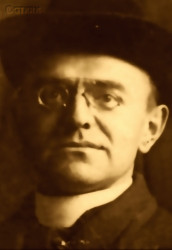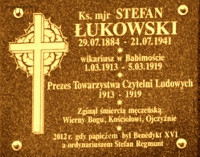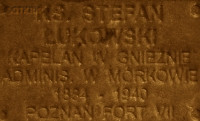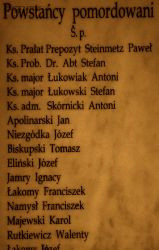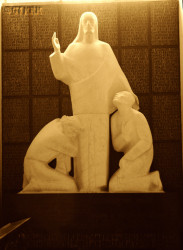Roman Catholic
St Sigismund parish
05-507 Słomczyn
85 Wiślana Str.
Konstancin deanery
Warsaw archdiocese, Poland
full list:
displayClick to display full list

searchClick to search full list by categories
wyświetlKliknij by wyświetlić pełną listę po polsku

szukajKliknij by przeszukać listę wg kategorii po polsku

Martyrology of the clergy — Poland
XX century (1914 – 1989)
personal data
surname
ŁUKOWSKI
forename(s)
Steven (pl. Stefan)
function
diocesan priest
creed
Latin (Roman Catholic) Church RCmore on
en.wikipedia.org
[access: 2014.09.21]
diocese / province
Gniezno and Poznań archdiocese (aeque principaliter)more on
www.archpoznan.pl
[access: 2012.11.23]
RC Military Ordinariate of Polandmore on
en.wikipedia.org
[access: 2014.12.20]
date and place
of death
21.01.1941

KL Posenconcentration camp
today: Poznań, Poznań city pov., Greater Poland voiv., Poland
more on
en.wikipedia.org
[access: 2022.01.09]
alt. dates and places
of death
02.02.1940 („official” date)
details of death
During his philosophical and theological studies in Poznań and Gniezno, a member of the clandestine Polish self‐educational Thomas Zan Society. Furthered his own education, but also taught younger colleagues history, geography and native literature, who could not learn about it in German schools.
At the end of World War I 1914‐1918, in 1917, ministered in the communal town of Babimost, in the western part of the Prussian Germ. Provinz Posen (Eng. Poznań Province), which included the Greater Poland region, right on the border with the Germ. Provinz Brandenburg (Eng. Brandenburg Province).
In the commune, Poles constituted about half of the inhabitants — the other half Germans. As the president of the Polish Youth Society founded in 1912, organized clandestine units of Polish youth that underwent initial military training. Established a female unit of the Polish Red Cross (to which the German authorities usually did not consent).
After the abdication on 09.11.1918 of the German Emperor William II Hohenzollern; after the signing on 11.11.1918 by the Allies and the Germans, in a staff wagon in Compiègne, at the headquarters of French Marshal Ferdinand Foch, of an armistice and ceasefire — which de facto meant the end of World War I; and also after the transfer on 11.11.1918 by the Regency Council established by the Germans — operating in the territory of the so–called Germ. Königreich Polen (Eng. Polish Kingdom) occupied by Germany and Austria–Hungary — of supreme authority over the army to Brigadier Joseph Piłsudski and his appointment as Commander‐in‐Chief of the Polish Army, which de facto meant the rebirth of the Polish state, however, covering only the area of the Germ. Königreich Polen, i.e. the Polish territory under Russian rule until 1915, but excluding the lands of the Prussian partition of Poland, which were still formally part of the German state; in Greater Poland, Polish centres of local power began to emerge, with the intention of incorporating Greater Poland into Polish state. The Germans responded by establishing centres of German power. Although in mid‐November 1918 a Workers' and Soldiers' Council was established in Babimost — consisting of 11 members, among them 5 Poles — and he became its chairman, this did not mean that both sides shared the interests, especially since the Germ. Grenzschutz Ost (Eng. Eastern Border Guard) became active — a German paramilitary, terrorist, volunteer formation, militarily opposing the separation of the eastern territories from Germany. The Poles began preparations for the uprising.
On 24.11.1918, a Polish rally took place in Babimost, with the participation of nearly 2,000 people. A resolution was passed demanding the annexation of the Babimost district to Poland and sent to the Supreme People's Council NRL in Poznań, which only a few weeks later, on 03‐05.12.1918, the Polish District Parliament (Seym), meeting in Poznań, recognized as Polish state authority, also expressing the will to annex the lands of the Prussian partition to a united Polish state with access to the sea.
The Greater Poland Uprising of 1918‐1919 broke out on 27.12.1918. Within a week Poznań was in Polish hands and fighting began throughout Greater Poland, particularly on its borders. On 24.01.1919 the insurgents took over Babimost. On 12.02.1919 the German counteroffensive began, during which the Germans retook Babimost, but failed to cross the Obra River line defended by the Poles. Prob. was then arrested by the Germ. Grenzschutz Ost and imprisoned in Międzyrzecz Wielkopolski.
A few days later, on 16.02.1919, the Uprising ended with a truce in Trier, enforced by the victorious Entente states, under which the Polish insurgent Greater Poland Army was recognised as an allied army and a border was set, which „German troops were forbidden to cross”, leaving a large part of Greater Poland beyond their influence. Was released from custody, but Babimost found itself on the German side.
Began a propaganda campaign for the annexation of the Western Borderlands to independent Poland. On 28.05.1919, as a member of the delegation of the NRL Commissariat, went to Paris to meet with the official representatives of the Polish government at the Paris Peace Conference, in order to inform them about the situation of the Polish population in the border counties of Greater Poland and their demands and postulates. In a statement issued that day, of which was a co–author, it was written: „The Republic of Poland has in the inhabitants of the Western Borderlands: in the Babimost, Międzyrzecz, Wschowa, Wieleń, patriotically conscious subjects who will constitute the vanguard of the Borderlands. By losing these people by being cut off from Poland, our country is losing a defensive rampart of no small importance […] We consider the Western Borderlands to be a bulwark against the Germans, a fortress defending Poznań and Warsaw against the German invasion. These Borderlands are the most important for Poland, this is the opinion ours”. The aforementioned peace treaty was signed by the Entente powers with Germany on 28.06.1919 in Versailles. In one of the points, Greater Poland was awarded to the Polish state, but the precise boundary line was left to the international Delimitation Commission. The Commission, which had the right to decide on the shape of the border in a 12 km strip around the border described in the treaty, began its work after the treaty came into force on 10.01.1920 (when the actual incorporation of Greater Poland into Poland was enforced). Babimost, however, remained within the borders of Germany and in fact never returned to his parish.
On 24.08.1919, spoke at a rally in support of Upper Silesia — in connection with the outbreak of the First Silesian Uprising of 16‐24.08.1919 — in his then parish Kostrzyn.
In the same 1919, became deputy chaplain of the Reserve Battalion of the 2nd Greater Poland Rifle Regiment in Szamotuły (10.12.1919 renamed the 56th Greater Poland Infantry Regiment, part of the 14th Infantry Division), where began his pastoral service as a vicar.
In 1920, during the Polish–Russian War of 1919‐1921, a volunteer chaplain of the Polish Army. Went to the battlefront together with students of the oldest year of the Agricultural School in Szamotuły, where was a prefect at that time.
After German and Russian invasion of Poland in 09.1939 and start of the World War II, after start of the German occupation, arrested by the Germans — by the Germ. Geheime Staatspolizei (Eng. Secret State Police), i.e. Gestapo — on 01.10.1940.
Held in Leszno prison.
Next taken to the KL Posen (Fort VII) concentration camp.
There murdered. According to the death certificate in the registers of the civil registry office in Poznań, No. 1/1232/1940, the „honest” otherwise German „medical doctors” and formalists — and at the same time, unrivaled fairy tale spinners — noted the cause of death was „suicide by hanging”.
cause of death
murder
perpetrators
Germans
sites and events
KL PosenClick to display the description, LesznoClick to display the description, «Intelligenzaktion»Click to display the description, Ribbentrop‐MolotovClick to display the description, Pius XI's encyclicalsClick to display the description, Polish‐Russian war of 1919‐1921Click to display the description, Greater Poland UprisingClick to display the description, Thomas Zan SocietiesClick to display the description
date and place
of birth
29.07.1884Birth certification on:
photos.szukajwarchiwach.gov.pl
[access: 2025.08.19]

Miejska Górkatoday: Miejska Górka gm., Rawicz pov., Greater Poland voiv., Poland
more on
en.wikipedia.org
[access: 2021.12.18]
parents
ŁUKOWSKI Severin
🞲 ?, ? — 🕆 ?, ?

SKWIERCZYŃSKA Nepomucena
🞲 ?, ? — 🕆 ?, ?
presbyter (holy orders)
ordination
30.01.1910

Poznańtoday: Poznań city pov., Greater Poland voiv., Poland
more on
en.wikipedia.org
[access: 2021.07.18]
St Peter and St Paul the Apostles RC archcathedral churchmore on
en.wikipedia.org
[access: 2025.03.14]
positions held
1936 – 1940
parish priest — Mórkowotoday: Lipno gm., Leszno pov., Greater Poland voiv., Poland
more on
en.wikipedia.org
[access: 2021.07.15] ⋄ All the Saints RC parish ⋄ Lesznotoday: Leszno city pov., Greater Poland voiv., Poland
more on
en.wikipedia.org
[access: 2021.07.18] RC deanery
1936
administrator — Wilkowo Polskietoday: Wielichowo gm., Grodzisk Wielkopolski pov., Greater Poland voiv., Poland
more on
en.wikipedia.org
[access: 2021.07.18] ⋄ St Hedwig of Silesia RC parish ⋄ Kościantoday: Kościan gm., Kościan pov., Greater Poland voiv., Poland
more on
en.wikipedia.org
[access: 2021.07.18] RC deanery — prob.
1934 – 1936
RC senior military chaplain — Cieszyntoday: Cieszyn gm., Cieszyn pov., Silesia voiv., Poland
more on
en.wikipedia.org
[access: 2021.12.18] ⋄ garrison, Command of the Corps District DOK No. V Kraków, Polish Armed Forces ⋄ St Andrew Bobola RC military parish — also: acting („ad interim”) administrator of a military parish (titular parish priest); chaplain of the 4th Podhale Rifle Regiment, stationed in the garrison
1930 – 1934
RC senior military chaplain — Gnieznotoday: Gniezno urban gm., Gniezno pov., Greater Poland voiv., Poland
more on
en.wikipedia.org
[access: 2021.12.18] ⋄ garrison, Corps District OK No. VII Poznań, Polish Armed Forces ⋄ St Stanislav the Bishop and Martyr RC military parish — in 1930 promotion: commissioned, with seniority of 01.01.1930, in the rank of major; also: military parish administrator (titular parish priest); resident of St Michael the Archangel parish in Gniezno
1925 – 1930
RC military chaplain — Gnieznotoday: Gniezno urban gm., Gniezno pov., Greater Poland voiv., Poland
more on
en.wikipedia.org
[access: 2021.12.18] ⋄ garrison, Corps District OK No. VII Poznań, Polish Armed Forces ⋄ St Stanislav the Bishop and Martyr RC military parish — also: military parish administrator (titular parish priest); resident of St Michael the Archangel parish in Gniezno
c. 1921 – 1925
RC military chaplain — Ostrów Wielkopolskitoday: Ostrów Wielkopolski urban gm., Ostrów Wielkopolski pov., Greater Poland voiv., Poland
more on
en.wikipedia.org
[access: 2021.06.07] ⋄ garrison, Corps District OK No. VII Poznań, Polish Armed Forces — commissioned; by decree of the Chief of State of ‐03.05.1922, confirmed with seniority from 01.06.1919 and 6th place on the list of Roman Catholic military chaplains, in the rank of captain; by decree No. L. 3448 of the Commander‐in‐Chief of 16.12.1921, verified with seniority from 01.04.1920 and 7th place on the list of Roman Catholic military chaplains, in the rank of captain; also: resident of St Stanislav the Bishop and Martyr parish
1920 – c. 1921
vicar — Lubasztoday: Lubasz gm., Czarnków/Trzcianka pov., Greater Poland voiv., Poland
more on
en.wikipedia.org
[access: 2021.06.20] ⋄ Nativity of the Blessed Virgin Mary RC parish ⋄ Czarnkówtoday: Czarnków gm., Czarnków/Trzcianka pov., Greater Poland voiv., Poland
more on
en.wikipedia.org
[access: 2021.06.20] RC deanery
1920 – 1921
RC military chaplain — Polish Armed Forces — by L. 2845 decree of the Commander‐in‐Chief of 14.04.1921, at the request of the Bishop's Curia of the Polish Army, demobilised from the Polish Army
1919 – 1920
vicar — Szamotułytoday: Szamotuły gm., Szamotuły pov., Greater Poland voiv., Poland
more on
en.wikipedia.org
[access: 2021.06.20] ⋄ St Stanislav the Bishop and Martyr RC parish ⋄ Szamotułytoday: Szamotuły gm., Szamotuły pov., Greater Poland voiv., Poland
more on
en.wikipedia.org
[access: 2021.06.20] RC deanery — also: prefect of the Agricultural School, renamed in 1920 to the Fr Peter Skarga Pro‐Gymnasium
1919
administrator — Kostrzyntoday: Kostrzyn gm., Poznań pov., Greater Poland voiv., Poland
more on
en.wikipedia.org
[access: 2021.12.19] ⋄ St Peter and St Paul the Apostles RC parish ⋄ Kostrzyntoday: Kostrzyn gm., Poznań pov., Greater Poland voiv., Poland
more on
en.wikipedia.org
[access: 2021.12.19] RC deanery
1919
vicar — Stary Gostyńtoday: Gostyń gm., Gostyń pov., Greater Poland voiv., Poland
more on
en.wikipedia.org
[access: 2021.07.15] ⋄ St Martin the Bishop and Confessor and St Stanislav the Bishop and Martyr RC parish ⋄ Gostyńtoday: Gostyń gm., Gostyń pov., Greater Poland voiv., Poland
more on
en.wikipedia.org
[access: 2021.07.18] RC deanery
1913 – 1919
vicar — Babimosttoday: Babimost gm., Zielona Góra pov., Lubusz voiv., Poland
more on
en.wikipedia.org
[access: 2021.07.18] ⋄ St Lawrence the Martyr RC parish ⋄ Zbąszyńtoday: Zbąszyń gm., Nowy Tomyśl pov., Greater Poland voiv., Poland
more on
en.wikipedia.org
[access: 2021.06.20] RC deanery
1910 – 1913
vicar — Janków Zaleśnytoday: Raszków gm., Ostrów Wielkopolski pov., Greater Poland voiv., Poland
more on
en.wikipedia.org
[access: 2021.07.18] ⋄ St Adalbert the Bishop and Martyr and Nativity of the Blessed Virgin Mary RC parish ⋄ Ostrów Wielkopolskitoday: Ostrów Wielkopolski urban gm., Ostrów Wielkopolski pov., Greater Poland voiv., Poland
more on
en.wikipedia.org
[access: 2021.06.07] RC deanery — also: county chairman of the People's Reading Rooms Society TCL
till 1910
student — Gnieznotoday: Gniezno urban gm., Gniezno pov., Greater Poland voiv., Poland
more on
en.wikipedia.org
[access: 2021.12.18] ⋄ philosophy and theology, Archbishop's Practical Theological Seminary (Lat. Seminarium Clericorum Practicum)
from 1906
student — Poznańtoday: Poznań city pov., Greater Poland voiv., Poland
more on
en.wikipedia.org
[access: 2021.07.18] ⋄ philosophy and theology, Archbishop's Theological Seminary (Collegium Leoninum)
others related
in death
CEGIEŁClick to display biography Thaddeus Vladimir Cornelius, FLACHClick to display biography Julian, GRAMLEWICZClick to display biography Edward, HARASYMOWICZClick to display biography Vincent, JANICKIClick to display biography Stanislav, JANKOWSKIClick to display biography Alphonse, KUBIKClick to display biography Alexander, MAŁECKIClick to display biography Stanislav, MANITIUSClick to display biography Gustav, MIROCHNAClick to display biography Steven Marian (Fr Julian), MZYKClick to display biography Louis, NIEDBAŁClick to display biography Anthony Marian, NOWAKClick to display biography Francis Joseph, PIOTROWSKIClick to display biography Ignatius, POPRAWSKIClick to display biography Marian, SĘKIEWICZClick to display biography Mauritius Vaclav, STEINMETZClick to display biography Paul, SZREYBROWSKIClick to display biography Casimir, TYMAClick to display biography Joseph, WIŚNIEWSKAClick to display biography Mary, WOŹNIAKClick to display biography Albin
sites and events
descriptions
KL Posen: German Posen — Fort VII — camp founded in c. 10.10.1939 in Poznań till mid of 11.1939 operated formally as Germ. Konzentrationslager (Eng. concentration camp) KL Posen, and this term is used throughout the White Book, also later periods. It was first such a concentration camp set up by the Germans on Polish territory — in case of Greater Poland (Wielkopolska) directly incorporated into German Reich. In 10.1939 in KL Posen for the first time Germans used gas to murder civilian population, in particular patients of local psychiatric hospitals. From 11.1939 the camp operated as German political police Gestapo prison and transit camp (Germ. Übergangslager), prior to sending off to concentration camps, such as KL Dachau or KL Auschwitz. In 28.05.1941 the camp was rebranded as police jail and slave labour corrective camp (Germ. Arbeitserziehungslager). At its peak up to 7‐9 executions were carried in the camp per day, there were mass hangings of the prisoners and some of them were led out to be murdered elsewhere, outside of the camp. Altogether in KL Posen Germans exterminated approx. 20,000 inhabitants of Greater Poland (Wielkopolska) region, including many representatives of Polish intelligentsia, patients and staff of psychiatric hospitals and dozen or so Polish priests. Hundreds of priests were held there temporarily prior to transport to other concentration camps, mainly KL Dachau. From 03.1943 the camp had been transformed into an industrial complex (from 25.04.1944 — Telefunken factory manufacturing radios for submarines and aircrafts). (more on: www.wmn.poznan.plClick to attempt to display webpage
[access: 2019.02.02], en.wikipedia.orgClick to attempt to display webpage
[access: 2013.12.27])
Leszno: Detention centre and prison during World War II run by Germans. After cessation of hostilities in 1945 prison run by Polish Commie‐Nazi authorities, controlled by Russians. (more on: www.sw.gov.plClick to attempt to display webpage
[access: 2013.08.17])
«Intelligenzaktion»: German: «Intelligenzaktion» (English: „Intelligence Action”) — a German program of extermination of the Polish elite, mainly the intelligentsia and leadership layers, carried out from the beginning of the occupation in w 09.1939 to 04.1940, mainly in territories directly annexed to Germany, but also in the so‐called Germ. Generalgouvernement (Eng. General Governorate), where it was called «AB‐aktion». In the first phase, immediately after the beginning of the German occupation, during military operations carried out by the Germ. Wehrmacht (Eng. Armed Forces) and the genocidal units of the Germ. Einsatzgruppen (Eng. Operational Groups) of the Germ. Sicherheitspolizei (Eng. Security Police), i.e. SiPo, and Germ. Sicherheitsdienst des Reichsführers SS (Eng. Security Service of the Reichsführer SS), i.e. SD, organized by the Germ. Reichssicherheitshauptamt (Eng. Reich Main Security Office), i.e. RSHA, which followed the troops, carried out under the Germ. Unternehmen „Tannenberg” (Eng. Operation „Tannenberg”) — based on the so‐called Germ. Sonderfahndungsliste (Eng. Special Wanted Lists), i.e. proscription lists of Poles considered particularly dangerous to the Third Reich, prepared by the Zentralstelle II/P (Polen) unit of the German RSHA. Later, implemented by the German civilian occupation authorities and the genocidal unit of the Germ. Volksdeutscher Selbstschutz (Eng. Ethnic Germans Self‐Defense), whose members were Germ. Volksdeutsche (Eng. Ethnic Germans), i.e. representatives of the German minority in Poland. According to various sources, these lists, at the beginning of 09.1939, could have contained the details of 61,000—88,000 „dangerous” Poles — although these figures cannot be confirmed. In total, during this genocide, c. 50,000 teachers, Catholic priests, representatives of the landed gentry, freelancers, social and political activists, and retired military personnel were systematically and methodically murdered. Another 50,000 were sent to concentration camps, where only a negligible percentage survived. (more on: en.wikipedia.orgClick to attempt to display webpage
[access: 2014.10.04])
Ribbentrop‐Molotov: Genocidal Russian‐German alliance pact between Russian leader Joseph Stalin and German leader Adolf Hitler signed on 23.08.1939 in Moscow by respective foreign ministers, Mr. Vyacheslav Molotov for Russia and Joachim von Ribbentrop for Germany. The pact sanctioned and was the direct cause of joint Russian and German invasion of Poland and the outbreak of the World War II in 09.1939. In a political sense, the pact was an attempt to restore the status quo ante before 1914, with one exception, namely the „commercial” exchange of the so‐called „Kingdom of Poland”, which in 1914 was part of the Russian Empire, fore Eastern Galicia (today's western Ukraine), in 1914 belonging to the Austro‐Hungarian Empire. Galicia, including Lviv, was to be taken over by the Russians, the „Kingdom of Poland” — under the name of the General Governorate — Germany. The resultant „war was one of the greatest calamities and dramas of humanity in history, for two atheistic and anti‐Christian ideologies — national and international socialism — rejected God and His fifth Decalogue commandment: Thou shall not kill!” (Abp Stanislav Gądecki, 01.09.2019). The decisions taken — backed up by the betrayal of the formal allies of Poland, France and Germany, which on 12.09.1939, at a joint conference in Abbeville, decided not to provide aid to attacked Poland and not to take military action against Germany (a clear breach of treaty obligations with Poland) — were on 28.09.1939 slightly altered and made more precise when a treaty on „German‐Russian boundaries and friendship” was agreed by the same murderous signatories. One of its findings was establishment of spheres of influence in Central and Eastern Europe and in consequence IV partition of Poland. In one of its secret annexes agreed, that: „the Signatories will not tolerate on its respective territories any Polish propaganda that affects the territory of the other Side. On their respective territories they will suppress all such propaganda and inform each other of the measures taken to accomplish it”. The agreements resulted in a series of meeting between two genocidal organization representing both sides — German Gestapo and Russian NKVD when coordination of efforts to exterminate Polish intelligentsia and Polish leading classes (in Germany called «Intelligenzaktion», in Russia took the form of Katyń massacres) where discussed. Resulted in deaths of hundreds of thousands of Polish intelligentsia, including thousands of priests presented here, and tens of millions of ordinary people,. The results of this Russian‐German pact lasted till 1989 and are still in evidence even today. (more on: en.wikipedia.orgClick to attempt to display webpage
[access: 2015.09.30])
Pius XI's encyclicals: Facing the creation of two totalitarian systems in Europe, which seemed to compete with each other, though there were more similarities than contradictions between them, Pope Pius XI issued in 03.1937 (within 5 days) two encyclicals. In the „Mit brennender Sorge” (Eng. „With Burning Concern”) published on 14.03.1938, condemned the national socialism prevailing in Germany. The Pope wrote: „Whoever, following the old Germanic‐pre‐Christian beliefs, puts various impersonal fate in the place of a personal God, denies the wisdom of God and Providence […], whoever exalts earthly values: race or nation, or state, or state system, representatives of state power or other fundamental values of human society, […] and makes them the highest standard of all values, including religious ones, and idolizes them, this one […] is far from true faith in God and from a worldview corresponding to such faith”. On 19.03.1937, published „Divini Redemptoris” (Eng. „Divine Redeemer”), in which criticized Russian communism, dialectical materialism and the class struggle theory. The Pope wrote: „Communism deprives man of freedom, and therefore the spiritual basis of all life norms. It deprives the human person of all his dignity and any moral support with which he could resist the onslaught of blind passions […] This is the new gospel that Bolshevik and godless communism preaches as a message of salvation and redemption of humanity”… Pius XI demanded that the established human law be subjected to the natural law of God , recommended the implementation of the ideal of a Christian state and society, and called on Catholics to resist. Two years later, National Socialist Germany and Communist Russia came together and started World War II. (more on: www.vatican.vaClick to attempt to display webpage
[access: 2023.05.28], www.vatican.vaClick to attempt to display webpage
[access: 2023.05.28])
Polish‐Russian war of 1919‐1921: War for independence of Poland and its borders. Poland regained independence in 1918 but had to fight for its borders with former imperial powers, in particular Russia. Russia planned to incite Bolshevik‐like revolutions in the Western Europe and thus invaded Poland. Russian invaders were defeated in 08.1920 in a battle called Warsaw battle („Vistula river miracle”, one of the 10 most important battles in history, according to some historians). Thanks to this victory Poland recaptured part of the lands lost during partitions of Poland in XVIII century, and Europe was saved from the genocidal Communism. (more on: en.wikipedia.orgClick to attempt to display webpage
[access: 2014.12.20])
Greater Poland Uprising: Military insurrection of Poles of former German Germ. Posen Provinz (Eng. Poznań province) launched against German Reich in 1918‐1919 — after the abdication on 09.11.1918 of the German Emperor William II Hohenzollern; after the armistice between the Allies and Germany signed on 11.1.1918 in the HQ wagon in Compiègne, the headquarters of Marshal of France Ferdinand Foch — which de facto meant the end of World War I — against the German Weimar Republic, established on the ruins of the German Empire, aiming to incorporate lands captured by Prussia during partitions of Poland in XVIII century into Poland. The Republic of Poland, reborn on 11.11.1918, initially formally included only the so‐called Germ. Königreich Polen (Eng. Kingdom of Poland), i.e. the territory that had been under Russian rule until 1915 and then under the control of Central States (Germany and Austria–Hungary), but did not include the Prussian partition. Started on 27.12.1918 in Poznań and ended on 16.02.1919 with the armistice pact in Trier, forced by the victorious Entente states, which included provisions ordering Germany to cease operations against Poland and, importantly, recognizing the Polish insurgent Greater Poland Army as an allied armed force of the Entente. De facto it turned out to be a Polish victory, confirmed in the main peace treaty after World War I, the Treaty of Versailles of 28.06.1919, which came into force on 10.01.1920 and in which most of the lands of the Prussian partition were recognized as Polish. Many Polish priests took part in the Uprising, both as chaplains of the insurgents units and members and leaders of the Polish agencies and councils set up in the areas covered by the Uprising. In 1939 after German invasion of Poland and start of the World War II those priests were particularly persecuted by the Germans and majority of them were murdered. (more on: en.wikipedia.orgClick to attempt to display webpage
[access: 2016.08.14])
Thomas Zan Societies: Secret societies of Polish youth, aiming at self‐education, patriotic in form and content, functioning 1830‐1920, in mutiny against enforced Germanisation and censure of Polish culture, mainly in secondary schools — gymnasia — mainly in Greater Poland (Wielkopolska) and later in Silesia. The first groups were formed in 1817. In 1897 a congress in Bydgoszcz was held when rules of clandestine activities were formulated. At other congress in Bydgoszcz in Poznań a „Red Rose” society was formed, heading all others groups in various gymnasiums and coordinating their activities. In 1900 „Red Rose” consolidated Philomaths organizations from Pomerania as well. After Toruń trial of Pomeranian Philomaths in Toruń Germans arrested 24 members of Thomas Zan Society from Gniezno. 21 of them were sentenced up to 6 weeks in prison and reprimands. All were relegated from schools without the right to continue education in secondary and higher schools in Prussia. Despite repression the Societies existed till 1918 and rebirth of Poland. (more on: pl.wikipedia.orgClick to attempt to display webpage
[access: 2021.12.19])
sources
personal:
www.wtg-gniazdo.orgClick to attempt to display webpage
[access: 2012.11.23], www.ordynariat.wp.mil.plClick to attempt to display webpage
[access: 2013.01.13], photos.szukajwarchiwach.gov.plClick to attempt to display webpage
[access: 2025.08.19], www.powiatwolsztyn.plClick to attempt to display webpage
[access: 2015.03.01]
original images:
www.powiatwolsztyn.plClick to attempt to display webpage
[access: 2015.03.01], www.babimost.plClick to attempt to display webpage
[access: 2016.08.14], www.wtg-gniazdo.orgClick to attempt to display webpage
[access: 2014.01.06]
LETTER to CUSTODIAN/ADMINISTRATOR
If you have an Email client on your communicator/computer — such as Mozilla Thunderbird, Windows Mail or Microsoft Outlook, described at WikipediaPatrz:
en.wikipedia.org, among others — try the link below, please:
LETTER to CUSTODIAN/ADMINISTRATORClick and try to call your own Email client
If however you do not run such a client or the above link is not active please send an email to the Custodian/Administrator using your account — in your customary email/correspondence engine — at the following address:

giving the following as the subject:
MARTYROLOGY: ŁUKOWSKI Steven
To return to the biography press below:
 Click to return to biography
Click to return to biography








